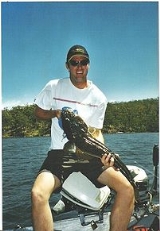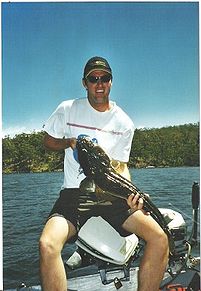
Dusky Flathead
Encyclopedia
The dusky flathead (literally translating from Ancient Greek as "flat-head dusky") is a large predatory fish
and the largest member of the Platycephalidae
family
. Dusky flathead are a largely estuarine
species and are found in estuaries, estuarine lakes and coastal bays on the east coast of Australia
, from Cairns in Queensland
to the Gippsland Lakes
in Victoria. They occur over sand, mud, gravel and seagrass and can inhabit estuarine waters up to the tidal limit.
. In contrast to flounder however, flathead are much more elongated, the tail remains vertical, and the mouth is large, wide and symmetrical. Flathead use this body structure to hide in sand (their body colour changes to match their background), with only their eyes visible, and explode upwards and outwards to engulf small fish and prawns as they drift over the hidden flathead.
 Dusky flathead are the largest of the many species of flathead found in Australia, and the most commonly caught. Dusky flathead have very rarely been caught at sizes up to 12–15 kg and lengths up to 1.5 metres, but average size is 0.5–1.5 kg and 40–50 cm. Typically a fish of estuaries and estuarine lakes, dusky flathead are rarely found in other habitats.
Dusky flathead are the largest of the many species of flathead found in Australia, and the most commonly caught. Dusky flathead have very rarely been caught at sizes up to 12–15 kg and lengths up to 1.5 metres, but average size is 0.5–1.5 kg and 40–50 cm. Typically a fish of estuaries and estuarine lakes, dusky flathead are rarely found in other habitats.
The current Australian record is held by Alan Strathearn Richmond River NSW 14/7/1983 for 9.440KG
The diet of dusky flathead is typically composed of smaller fish and prawns.
Dusky flathead are reported to be hermaphroditic, starting as males and changing to females at a relatively large size, but this has been disputed in more recent studies. Certainly only female fish attain the larger sizes. Breeding is reported to occur in mid to late summer around estuary mouths.
. In the face of heavy fishing pressure and more effective techniques, a largely catch and release
approach from anglers is essential nowadays to conserve dusky flathead stocks. Many fishermen generally release dusky flatead over 70cm, recognising that they are important large breeding females.
Fish
Fish are a paraphyletic group of organisms that consist of all gill-bearing aquatic vertebrate animals that lack limbs with digits. Included in this definition are the living hagfish, lampreys, and cartilaginous and bony fish, as well as various extinct related groups...
and the largest member of the Platycephalidae
Platycephalidae
Platycephalidae is a family of marine fishes, most commonly referred to as flatheads. They are relatives of the popular lionfishes, belonging to the order Scorpaeniformes....
family
Family (biology)
In biological classification, family is* a taxonomic rank. Other well-known ranks are life, domain, kingdom, phylum, class, order, genus, and species, with family fitting between order and genus. As for the other well-known ranks, there is the option of an immediately lower rank, indicated by the...
. Dusky flathead are a largely estuarine
Estuary
An estuary is a partly enclosed coastal body of water with one or more rivers or streams flowing into it, and with a free connection to the open sea....
species and are found in estuaries, estuarine lakes and coastal bays on the east coast of Australia
Australia
Australia , officially the Commonwealth of Australia, is a country in the Southern Hemisphere comprising the mainland of the Australian continent, the island of Tasmania, and numerous smaller islands in the Indian and Pacific Oceans. It is the world's sixth-largest country by total area...
, from Cairns in Queensland
Queensland
Queensland is a state of Australia, occupying the north-eastern section of the mainland continent. It is bordered by the Northern Territory, South Australia and New South Wales to the west, south-west and south respectively. To the east, Queensland is bordered by the Coral Sea and Pacific Ocean...
to the Gippsland Lakes
Gippsland Lakes
The Gippsland Lakes are a network of lakes, marshes and lagoons in east Gippsland, Victoria, Australia covering an area of about 600 km2. The largest of the lakes are Lake Wellington , Lake King and Lake Victoria. They are fed by the Avon, Thomson, Latrobe, Mitchell, Nicholson and Tambo...
in Victoria. They occur over sand, mud, gravel and seagrass and can inhabit estuarine waters up to the tidal limit.
Morphology
Flathead are notable for their unusual body shape, upon which their hunting strategy is based. Flathead are dorsally compressed, meaning their body is wide but flattened and very low in height. Both eyes are on the top of the flattened head, giving excellent binocular vision to attack overhead prey. The effect is somewhat similar to flounderFlounder
The flounder is an ocean-dwelling flatfish species that is found in coastal lagoons and estuaries of the Northern Atlantic and Pacific Oceans.-Taxonomy:There are a number of geographical and taxonomical species to which flounder belong.*Western Atlantic...
. In contrast to flounder however, flathead are much more elongated, the tail remains vertical, and the mouth is large, wide and symmetrical. Flathead use this body structure to hide in sand (their body colour changes to match their background), with only their eyes visible, and explode upwards and outwards to engulf small fish and prawns as they drift over the hidden flathead.
Ecology

The current Australian record is held by Alan Strathearn Richmond River NSW 14/7/1983 for 9.440KG
The diet of dusky flathead is typically composed of smaller fish and prawns.
Dusky flathead are reported to be hermaphroditic, starting as males and changing to females at a relatively large size, but this has been disputed in more recent studies. Certainly only female fish attain the larger sizes. Breeding is reported to occur in mid to late summer around estuary mouths.
Fishing
Dusky flathead are a popular species for fishing and eating, and are heavily fished for. They readily take baits and minnow lures, and on such lures are good fighters. Recently they have proven to be very vulnerable to fishing techniques using jigged soft plastic luresJig (fishing)
Jigging is the practice of fishing with a jig, a type of fishing lure. A jig consists of a lead sinker with a hook molded into it and usually covered by a soft body to attract fish. Jigs are intended to create a jerky, vertical motion, as opposed to spinnerbaits which move through the water...
. In the face of heavy fishing pressure and more effective techniques, a largely catch and release
Catch and release
Catch and release is a practice within recreational fishing intended as a technique of conservation. After capture, the fish are unhooked and returned to the water before experiencing serious exhaustion or injury...
approach from anglers is essential nowadays to conserve dusky flathead stocks. Many fishermen generally release dusky flatead over 70cm, recognising that they are important large breeding females.

